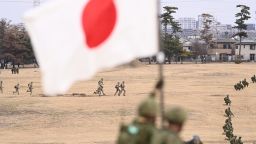
Japan is set to strengthen its military capabilities by arming the JS Chokai, an Aegis-equipped guided-missile destroyer, with Tomahawk cruise missiles capable of striking targets up to 1,000 miles away. The warship is currently en route to the United States for a year-long deployment that will include modifications and crew training for the new weapons system. This move underscores a broader effort by Washington and its Asian allies to bolster their military presence in response to expanding threats from adversaries like China and North Korea.
The acquisition of the Tomahawk missiles is part of Japan’s strategy to enhance its defense posture in what Defense Minister Gen Nakatani describes as the “most severe and complex security environment” since World War II. In early 2024, Japan signed a deal to purchase 400 Tomahawk missiles, a significant component of its increased defense spending aimed at countering regional threats.
Rising Threats and Strategic Responses
According to Japan’s Defense Ministry, China’s military activities pose “the greatest strategic challenge” to the nation. The annual white paper released in July highlighted concerns regarding Beijing’s rapid military enhancements and increased regional assertiveness, particularly around the contested Senkaku Islands. These islands, while controlled by Japan, are claimed by China, which refers to them as the Diaoyus. During a military parade on September 3, 2023, China showcased its advanced anti-ship missiles, highlighting its growing capabilities.
The deployment of the JS Chokai to the US for Tomahawk missile training reflects Japan’s commitment to strengthening its defensive measures. The destroyer will be prepared for “actual missions” by summer 2024, with live-fire testing planned as part of the training process. Initial steps occurred recently when the Chokai successfully practiced loading dummy Tomahawk munitions into its vertical launch cells. The 528-foot-long, 9,500-ton destroyer is equipped with 90 vertical launch cells capable of launching a variety of missiles, making it comparable in size and armament to the US Navy’s Arleigh Burke-class destroyers.
International Implications and Regional Reactions
While Japan emphasizes the defensive nature of the Tomahawk missiles, they are widely viewed as offensive weapons. A fact sheet from the US Navy categorizes them as “used for deep land-attack warfare,” indicating their potential to strike deep into adversary territory. This capability has drawn criticism from China, which has accused Japan of violating its post-World War II pacifist constitution, which limits the role of the Japan Self-Defense Forces to defensive operations.
Chinese Foreign Ministry spokesperson Mao Ning asserted that Japan’s military enhancements contribute to an escalating arms race, which threatens regional peace and stability. The tension between these nations has been further exacerbated by the recent military collaboration between China and North Korea, with North Korean leader Kim Jong Un inspecting missile developments shortly after the Beijing military parade.
The Tomahawk missiles’ versatility is noteworthy, as they can be launched from naval vessels, submarines, and land platforms. According to Raytheon, the missile manufacturer, Tomahawks have been successfully employed in combat over 2,000 times, including recent strikes against Iranian nuclear facilities.
In addition to Japan, other allies such as Australia are also enhancing their naval capabilities. Australia successfully fired a Tomahawk from the destroyer HMAS Brisbane off the US West Coast in December 2022. The Australian Defense Ministry plans to acquire 200 Tomahawks to enable long-range precision strikes against land targets.
As Japan moves forward with its military modernization, the implications of these developments extend beyond national defense, influencing the broader geopolitical landscape in the Asia-Pacific region.







